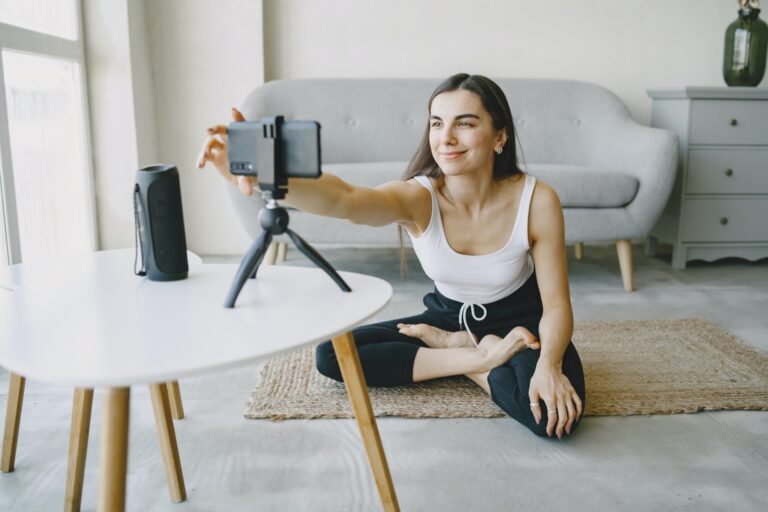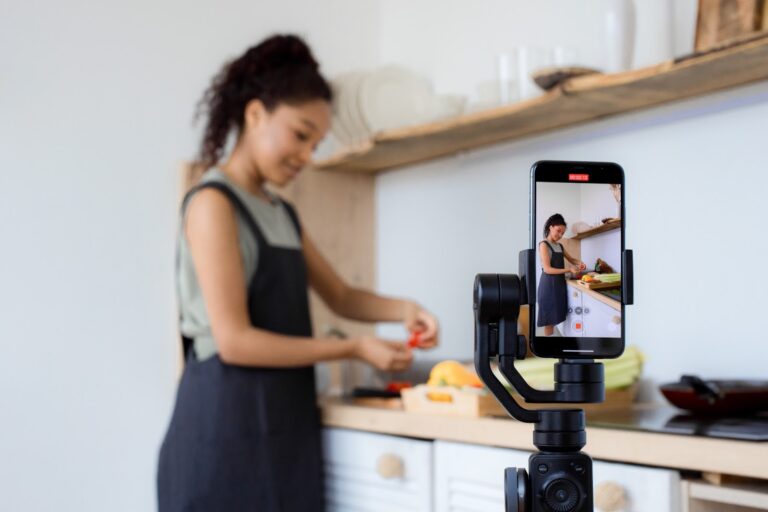What is Influencer Marketing, How Does It Work, and What's the Situation in the UK?

Tanel Vetik
Head of Strategy
Every day, we encounter thousands of notifications from brands – on the streets, on our devices, screens, and in print. Social media users have long been accustomed to companies and brands announcing discounts and advertising new collections. Businesses need to search for potential customers like a needle in a haystack, and constantly invent more effective methods of engaging both their existing consumers and potential new ones.

This is where influencer marketing comes in – the hottest trend in B2C marketing (and B2B in some cases) in recent years. Reaching consumers through a channel they use every day, and doing so through a person they trust is every sales manager’s dream. But what’s the situation with influencer marketing in the UK? It’s big in the States and are there sectors where influencers are not beneficial. Let’s dive into it.
What is Influencer Marketing, How Does It Work, and What's the Situation in the UK?

Tanel Vetik
Head of Strategy
Every day, we encounter thousands of notifications from brands – on the streets, on our devices, screens, and in print. Social media users have long been accustomed to companies and brands announcing discounts and advertising new collections. Businesses need to search for potential customers like a needle in a haystack, and constantly invent more effective methods of engaging both their existing consumers and potential new ones.
This is where influencer marketing comes in – the hottest trend in B2C marketing (and B2B in some cases) in recent years. Reaching consumers through a channel they use every day, and doing so through a person they trust is every sales manager’s dream. But what’s the situation with influencer marketing in the UK? It’s big in the States and are there sectors where influencers are not beneficial. Let’s dive into it.

Every day, we encounter thousands of notifications from brands – on the streets, on our devices, screens, and in print. Social media users have long been accustomed to companies and brands announcing discounts and advertising new collections. Businesses need to search for potential customers like a needle in a haystack, and constantly invent more effective methods of engaging both their existing consumers and potential new ones.

This is where influencer marketing comes in – the hottest trend in B2C marketing (and B2B in some cases) in recent years. Reaching consumers through a channel they use every day, and doing so through a person they trust is every sales manager’s dream. But what’s the situation with influencer marketing in the UK? It’s big in the States and are there sectors where influencers are not beneficial. Let’s dive into it.
What is influencer marketing, really?
In short, influencer marketing involves opinion leaders in brand storytelling and engaging consumers on a more personal level. This is done through social networks (YouTube, Instagram, FB, TikTok, Snapchat, events, etc.). It’s not necessarily limited to online channels; influencers can also be invited to visit a trade show booth or to participate at in-person events.
Influencers can be celebrities, people with unique knowledge, athletes, public figures, brand ambassadors, or even ordinary people with an active following. Collaborations can be with one influencer or a larger group to extend reach as much as possible to the consumer base in any given market segment.
While most collaborations are aimed at reaching consumers directly (B2C), there are also B2B influencers whose audience is largely industry professionals, such as construction, professional tools, and business services. Over time, influencers have gained expertise and earned their followers’ trust, making them a more accessible channel to reach the everyday consumer and help give a sense of security to help with the buying decision.
Content creators usually have a specific niche, like fashion, makeup, software, sports, technology, or other areas. Followers often consume their content specifically for these interests. But there are some exceptions. For example, it’s a public secret that much of a female sportswear influencer’s follower base is male – it’s not the intended product user.
How does influencer marketing work?
It’s actually quite simple. Identify the goals, choose a suitable collaboration partner or communicate directly with influencers, send them the project brief, approve the work done, measure results, and conduct follow-up activities.
There are many forms of collaboration, but here are the most popular ones:
- Sending gifts: the selected celebrity is sent a gift, and they make a post about it on their social media channels. This approach is clearly marketing, but it also serves as a product review by someone the audience trusts.
- Direct collaboration: influencers are sent product samples or provided a service, and they make posts that become the property of the company. The client can then use these in their social media marketing campaigns, display them on their website, or use them wherever they wish.
- Events: influencers are invited to cover an event for their audience. This is commonly used for openings, exhibitions, or regular events (like film festivals, trade shows, theatres, etc.).
- Sponsorship: influencers receive product samples or services and create posts where they talk more about the product or service, describing the user experience and highlighting value propositions. This is usually a long-term collaboration where the product is something that you consume over time (like supplements for example).
- Ambassadorship: if profitability requires high customer lifetime value, the goal is to build brand loyalty. In this case, collaborations are made with selected influencers over a longer period, with certain restrictions and obligations (e.g., not working with competing brands, frequency limitations). This works well for expensive products or services that are not frequently purchased, or products aimed at upselling.

Prominent examples of ambassador marketing are beauty bloggers using certain cosmetics to create an image, or travellers recommending booking accommodations through a specific website (e.g., recommending Holiday Inn whenever staying at a country).
Influencer marketing relies on two behavioural factors: the desire to emulate an idol (if a public figure says they use a particular face cream, people feel compelled to buy it) and trust in the expert’s opinion. This is why you should never choose to collaborate with a “sellout” influencer, who does collaborations with lots of random businesses and does not have a dedicated niche.
Advantages of influencer marketing for businesses
It depends on the business. For some businesses traditional Facebook advertising works better, and influencer marketing seems complicated (e.g., arborists), but for others, it’s ideal (cosmetic brands).
Influencer marketing can be incorporated into any field. While it doesn’t have to be the central tool in your digital strategy, creating more brand touchpoints increases the likelihood of customers engaging with your products. If these brand touch points can be created at a good price, then this channel makes sense for you as well.
Some advantages of influencer marketing include:
- Accessibility: previously, only large companies with significant budgets could influence consumer habits. An example of this is long-term advertising with Clint Eastwood, who shaped the image of the “real smoking man”. Today, even a small regional company can afford to collaborate with 10 different influencers, each with 500-2000 relevant followers.
- Higher trust in influencer materials: influencer materials are trusted 63-65% more than traditional advertising. Meanwhile, over 92% of internet users listen to other people’s reviews and recommendations before making a final purchase decision. This is online word-of-mouth advertising tailored just like you need it.
- Greater effectiveness: analysis shows that nearly 40% more customers make a purchase decision based on an influencer’s recommendation. On average, every invested 1€ brings back 6.5€ in sales revenue over a couple of months after the campaign.
- The continuous growth of internet influence and number of bloggers: the number of television viewers is decreasing by 9.5% per year, shifting to social networks. Watching movies and shows is moving to Netflix and Amazon Prime, and the latest news are consumed in summaries from YouTube or someone’s live recording on Facebook/Tik-Tok.
The state of influencer marketing in the United Kingdom
Promoty have conducted a survey among marketers and influencers to understand how consciously and strategically influencer marketing is done: how partners are chosen, which tools are used, and common concerns in the field.
The survey involved 510 marketers, most of whom work in the fashion and beauty sectors.
The most popular and primary platform for collaborations was Instagram, chosen by 94% of respondents. Next was Facebook (54% of respondents), followed by blogs (44%), YouTube (30%), and TikTok (10%).
These results reflect international studies: Influencer Marketing Hub’s global “The State of Influencer Marketing” summary confirmed that the majority, 68% of marketers, collaborate through Instagram. This was followed by TikTok, used by 45% of marketers.
Think about the last time you chose a gift, service, or even accommodation for someone close to you. Can you confidently say that others’ opinions on that item played no role in your decision?
Influencer marketing is going to be a rising trend for the next five to ten years; it’s already being used to sell almost all products online and offline. The easy tasks have all been done by now, leaving only hard work for anyone looking to jump on this speeding train. To genuinely reach your consumers, you must think outside the box and present the right value proposition to the right person at the right time. But you must also keep in mind that the type of mediums you choose will play a big part in your overall marketing profitability.
Influencer marketing is an effective brand tool but not a replacement for content marketing or digital advertising. Working with the wrong influencer can actually harm your brand (thinking about Bud Light here). Therefore, it’s important to focus more on targeting and understanding the consumer base.
